


By Abhinav Chandekar, Soumya Vats
Every now and then, interview clips of industry representatives speaking skeptically about films with female protagonists make the rounds. Questions are often raised about the commercial viability of films whose stories are centered around female protagonists. Such films are often relegated to the periphery of mainstream cinema, into a niche that exists only for a small group of creators who are willing to take on a bigger “financial risk”. Successes like Gangubai Kathiawadi are seen as anomalies, with the credit of their box office performance being largely attributed to other factors (like the director’s equity in this case).
We decided to seek an objective, data-led answer to the question: Do Hindi theatrical films led by female protagonists make less business sense than those led by male protagonists?
To perform this analysis, we looked at Hindi (original language) films that released theatrically between 2017 and 2022. The top 150 films based on lifetime box office collections in India were identified, and then classified into three categories based on the gender of their chief protagonist(s). This classification is done based on the gender of the character (or characters) whose story is at the center of the narrative, and whose perspective is used to propel the story forward. The three categories are:
1. Male: Films with only male protagonist(s), e.g., War, Kabir Singh & Brahmāstra
2. Female: Films with only female protagonist(s), e.g., Veere Di Wedding, Mardaani 2 & Raazi
3. Shared: Films with at least one male and at least one female protagonist, e.g., Good Newwz, Luka Chuppi & Kedarnath
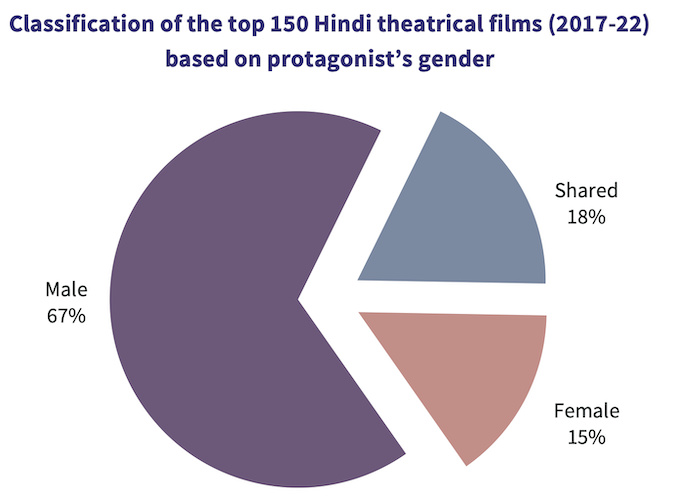
67% of the top 150 Hindi films released between 2017 and 2022 are led by male protagonists. In sharp contrast, only one in about seven films is female-led. Upfront, this highlights the wide chasm, and the potential damage pre-existing notions about commercial viability of female-led films has on their commissioning.
Next, an analysis was performed on various business metrics, to understand the difference in the business performance and audience response to films in the three categories.
Box Office
We looked at the average (median) First Day and Lifetime domestic (nett) box office of films in the three categories:
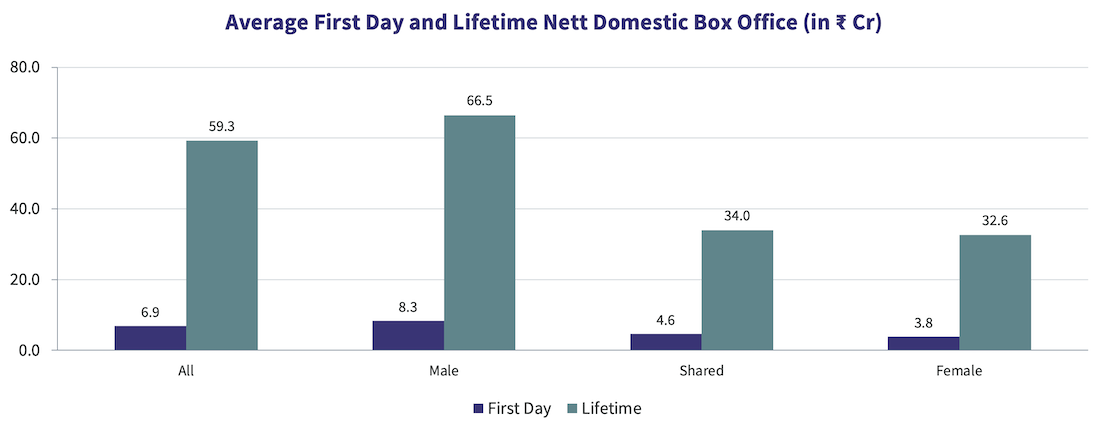
Average box office of films led by female protagonist is about 50% of those led by male protagonists. On its own, this chart paints a bleak picture for female-led films. But it needs to be viewed in conjunction with the budget of the film, to fully understand the commercial performance of films in the three categories.
Budget
For the purpose of this analysis, budget of a film has been defined as a sum of production costs and the marketing costs associated with its release. The chart below captures the average (median) budget of films belonging to the three categories:
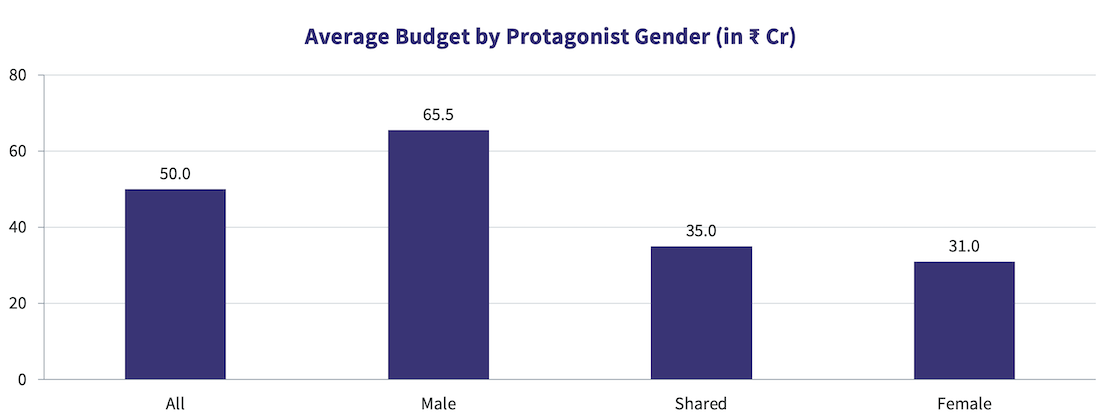
While films with female protagonists make half as much as films with male protagonists at the box office, the chart above highlights that they need less than half the amount of money to be produced and marketed. Hence, from an ROI (Return on Investment) perspective, male-led and female-led films have parity in performance, as the ratio of box office performance to total budget, is uncannily similar.
Success Rate
For Success Rate, each of the top 150 films was classified as either Hit, Average or Flop, based on their theatrical recoveries worldwide (non-theatrical income, such as streaming and satellite rights, has not been considered). Hit films are those that managed to comfortably recuperate cost of production and marketing at the box office, Average films are those that broke even, or made a minor profit/loss, while Flop films are those that suffered significant financial losses at the box office.
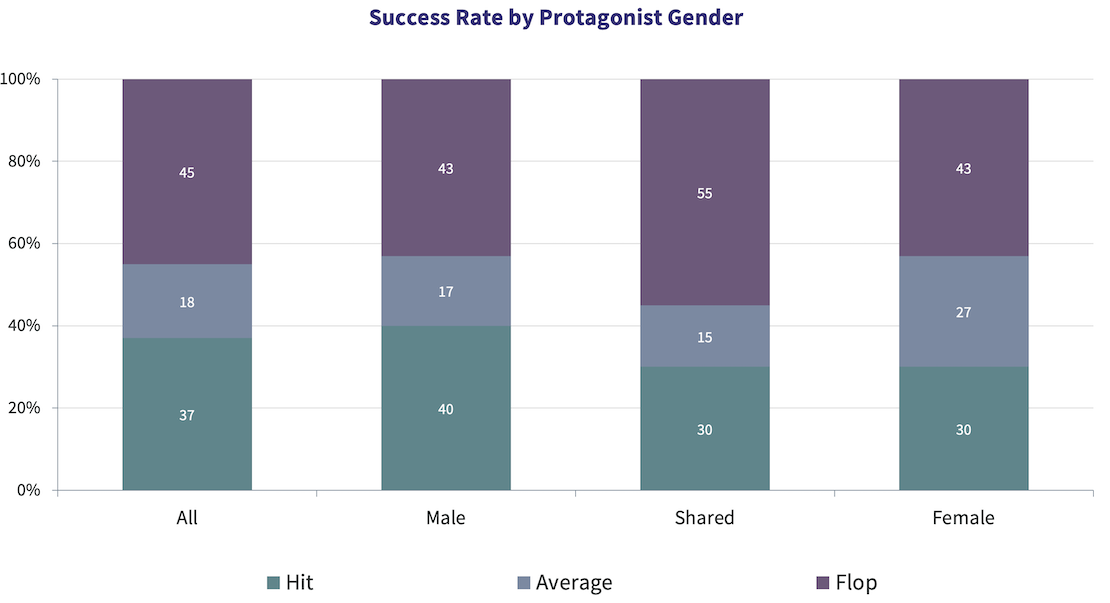
The chart above indicates that, at an overall level, among the top 150 films released between 2017 to 2022, 37% films were hits (this percentage would be lower if films beyond the top 150 were also included). 55% of the top 150 films fall in the Hit or Average category. This number is lower in the Shared category (45% compared to 57%) primarily due to the lower appeal of the romance genre, to which many of the films in this category belong.
While there is disparity in the percentage of hits (i.e., 40% hits among films led by male protagonists vs. 30% among films led by female protagonists), the percentage of flops is the same for both categories, at 43% each. This dispels the notion that the chance of failure is higher among films with female leads and stories. In other words, male-led films are as likely to flop as female-led films.
Ormax Power Rating (OPR)
Ormax Power Rating (OPR) is a score on a 0-100 scale that represents how much a film is liked by its viewers. We collect OPR data for all major films for four weeks post their release. Only viewers of the film are asked to score it on our proprietary OPR scale. Hence, OPR is a footfalls-agnostic measure. A film may have five times the box office collections of another, but have much lower OPR, because the latter may have found more love in its small and focused target group.
OPR is also the central measure used in our content testing products (see this explainer). Higher OPR leads to higher conversion of first-day box office to lifetime box office. OPR is a measure of audience likability and their disposition to recommend a film to their friends and family. The chart below captures the median OPR for the top 150 films released between 2017 to 2022, for the three categories:
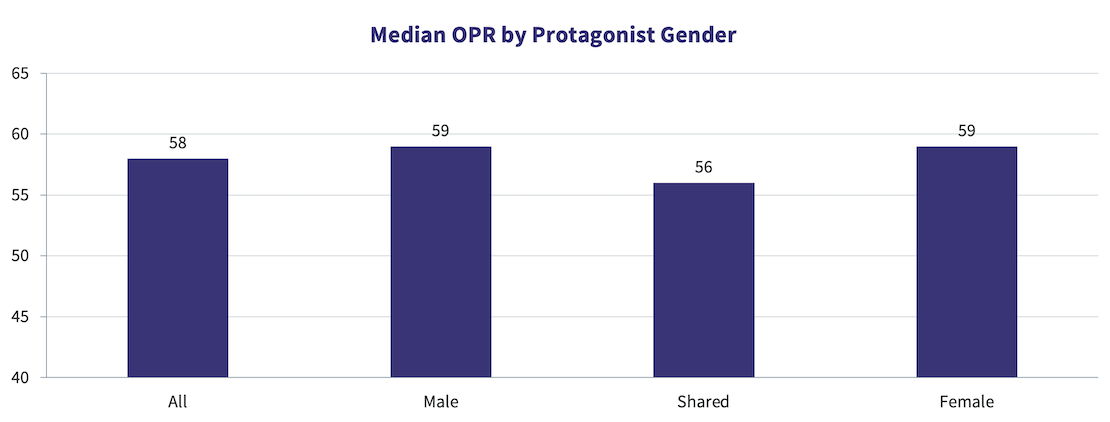
While an average male protagonist led film has considerably higher box office than a shared, or a female protagonist led film, the average OPR of the male and female categories has no difference. In simple terms, there is no disparity in male-led and female-led films in terms of audience likability and engagement, once they decide to step into a theatre to watch it. Therefore, notions that stories with female protagonists have lower likability are simplistic, if not flawed.
Conclusion
The theatrical universe is dominated by male viewers, which inevitably trickles into representation of male experiences as the dominant form of storytelling. This, coupled with notions of female-led stories being a riskier business proposition, has resulted in only 15% of the top 150 Hindi theatrical films released from 2017 to 2022 having a female protagonist in the lead. However, data points in this article suggest parity between male protagonist led and female protagonist led films, both in terms of audience likability and ROI. While it is too early to comment on how this will change and evolve in a post-pandemic world, with not enough examples for a robust analysis, what is clear is that there is need for better gender balance in the stories that we tell, and that commercial viability and audience’s appetite is not a major stumbling block in this pursuit.

Ormax Cinematix's FBO: Accuracy update (November 2025)
This edition of our monthly blog summarises Ormax Cinematix's box office forecasts (FBO) for all major November 2025 releases vis-à-vis their actual box-office openings

Product update: Content testing for the horror genre
Based on our accumulated audience insights, we are introducing genre-specific drivers for horror films and series in our content testing tools, Ormax Moviescope and Ormax Stream Test

The India Box Office Report: October 2025
Driven by Kantara - A Legend: Chapter-1, October 2025 has emerged as the highest-grossing box office month of the year at the India box office, with gross collections of ₹1,669 Cr
Subscribe to stay updated with our latest insights
We use cookies to improve your experience on this site. To find out more, read our Privacy Policy